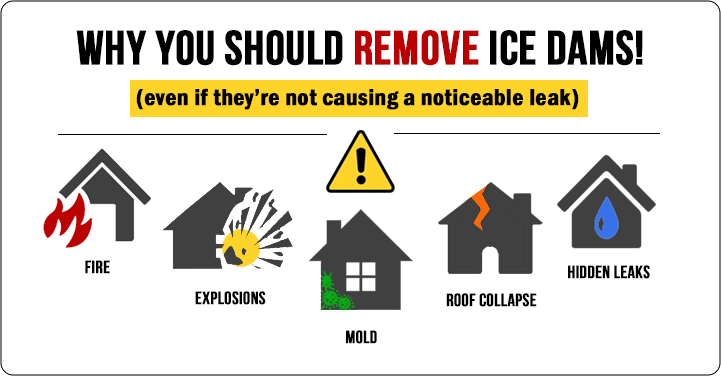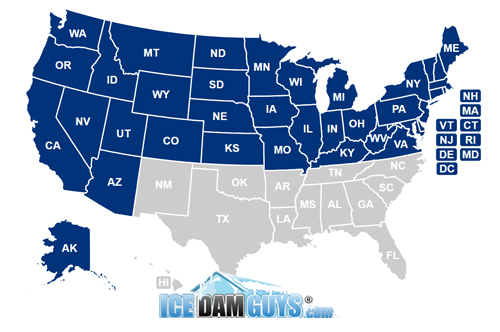Dirty Job: a Day of Ice Dam Removal
Ice dams are a simple problem: a bunch of ice collects on your roof during the winter. Removing them should also be simple, right?
Not for my company, Ice Dam Guys®. I’ve been removing ice dams since 1996. Usually when you’ve spent years and years doing something it gets simpler and easier. But I’ve found that proper ice-dam removal is never easy. After all, you’re trying to remove hundreds of pounds of ice from a slippery roof (15+ feet off the ground) in the freezing cold, while trying to do it safely and not damage the house. The more you do it, the more you discover all the ins and outs of safe and effective ice-dam removal.
The phone call
Each ice dam job begins with a phone call from an anxious homeowner who wants to slow the water leakage through the roof and avoid serious damage to the interior of the home.
The first thing we ask the homeowner is what material the roof is made of. Most people have the classic asphalt-shingled roof, but metal roofs are gaining popularity due to the increasing cost of asphalt (a petroleum-based product).
It’s difficult to climb onto a metal, glass, or slate roof during the winter, so if a homeowner’s roof is made of these materials, we need to perform our work from a ladder or with the aid of a man-lift. We also ask the homeowner how high the roof is, so we can bring a ladder or lift that’s tall enough to reach all the eaves of the roof.
The next thing we ask the homeowner is what the pitch of the roof is. Some people know that their roof is a 4/12 pitch, or a 6/12 pitch, etc., whereas others aren’t sure. To homeowners who don’t know their pitch, we ask one question: “If it were summer, could a person easily walk on your roof?” The answer is either a quick “Yes,” or they pause and say “Well, it’s pretty steep up there….” If we get the sense that the customer’s roof is very steep, we send out a special technician with the proper skills and safety equipment for working on a steep roof. In general, steeper roofs don’t collect ice dams as easily in the first place; the flatter, 4/12-pitch roofs make up most of our business.
Where’s the water?
Next, we ask whether we will have access to water. If the answer is “no” removing the ice dams is impossible, because we use steam-blasters to remove the ice. Other methods can work, like clobbering off the ice with hammers and chisels, but they’ll often destroy your shingles. Proper ice-dam removal requires steam, and steam requires water. Fortunately, there’s almost always a way to get the water we need for our steamers.
Most homeowners turn off their water spigots for the winter but they are often surprised when we say that all they need to do is turn one of their water spigots back on. If it’s frozen, we use a special heat-gun (similar to a hair dryer) that can usually get the water flowing in less than 10 minutes. If that fails (which is rare), we’ll run a garden hose inside to their laundry tub or tap into the water supply of the washing machine. If this water source doesn’t provide enough gallons-per-minute for our steamers, our last resort is to use a neighbor’s water supply (with permission, of course). We almost always find a good water source.
Proper Planning Prevents Poor Performance
We let the homeowner know that the average ice dam removal job typically takes between 2-4 hours to complete – longer if the ice dams are severe or if we need to use a ladder or lift due to a steep roof or unusual roofing materials.
Because ice dams usually are buried under a heavy blanket of snow, there is no way to know how large the ice dam is until we’ve removed the snow. This is why can’t provide free estimates.
We also mention that the size of the home doesn’t necessarily determine how long the ice removal will take: just because you have a small home doesn’t mean it will be quick to remove ice dams, and conversely just because you have a big home doesn’t mean it will take longer to remove the ice dams.
Last, we ask whether our client will be home. It’s not absolutely necessary that they be home, but we encourage it for a number of reasons. First, if there’s any difficulty in accessing water from the spigot, we need access to an indoor water supply. Second, occasionally leaks caused by the ice dam will get worse before we can make them better. Even though this rarely happens, it helps if the homeowner can be indoors to keep an eye out for increased leakage. If for some reason the homeowner can’t be home, one of our technicians will walk them through the entire process and routinely update them of the progress over the phone.
The best time to remove ice dams is in the mid-afternoon, when the sun is out in full force and the ice can soften a little bit. If we receive a call from a customer who is flexible in terms of time and doesn’t have an urgent situation (e.g. water in their home) we’ll almost always try to schedule them for an afternoon appointment.
Ride into ice-dam battle armed to the teeth
While packing up the truck, we follow one main rule: bring TWO of everything. It’s freezing cold, you’re spraying steam while standing on a slick sloped roof, and everything is covered in a layer of ice. “Murphy’s Law” applies: whatever can break, often will break. You need a replacement immediately at hand, because you can’t turn off the steamer for more than a couple of minutes, or else the water in the hose and the pump will freeze and the ice-dam removal will have to wait until another day (after our equipment has thawed).
Our truck probably carries more gear than the Apollo astronauts brought into space, but we’ve found it’s just enough to ensure that the job gets done efficiently and safely. We bring to each home the following: two poly-edged roof shovels, a heavy-duty metal grain shovel, two steamer wands, two 100’ lengths of high-pressure steamer hose, two 100’ lengths of garden hose, a heat-gun, a 100’ electric extension cord, a climbing harness, a 100’ section of climber’s rope, a 24’ extension ladder, an 8’ step ladder, a roof rake, a fire extinguisher, a roll of thread tape, a 5-gallon antifreeze bucket, a gallon of CLR, an empty 5-gallon bucket, 50 lbs. of granular ice melt, a box of assorted O-rings, a small toolbox full of assorted tools, a flashlight, a digital camera, two 5-gallon diesel cans, a 5-gallon fuel can, several traffic cones, a roll of “Caution” tape, rain gear, warm clothes… and the list goes on even longer!
The one thing we never bring to a home is an under-powered pressure washer. We use only steamers capable of producing a minimum of 250°F steam. Many inexperienced ice-dam removers simply use hot-water pressure-washers that shoot out 180°-240°F hot water. This underpowered equipment floods your roof with gallon upon gallon of hot water that only slowly melts the ice. More water is the last thing you want when your house is already leaking due to ice dams. If any ice-dam removal “experts” show up to your house with a steamer that won’t reach 250°F, grab your broom and shoo them away. The bottom line is you can’t make steam if you can’t heat water to 250°F. And if you’re not using steam all you’re doing on someone’s roof is destroying it.
Clearing the snow
Ice dams usually run along the entire overhang of the roof and/or within the roof valleys. Right before we flick on the steamer, we clear off a long swath of snow, approximately 6-8 feet up the roof and along the entire length of the roof. We may also clear the valleys if we suspect ice build-up is hiding beneath the snow.
In most cases we need to clear the snow in order to find and fully expose the ice dam(s) before we can actually remove them. We do this to make sure that at all times we can stand on clean, snow-free shingles. Unfortunately, many inexperienced ice-dam removers just hop onto a snowy part of the roof that seems to give them the best footing. This is a huge mistake, because the footsteps pack down the snow, which eventually hardens into ice and forms another ice dam, this time right in the middle of the roof where they were standing. We like to get the job done efficiently and not have the homeowner pay for hours spent removing the ice dams caused by a man’s boots (and his inexperience). I can’t begin to tell you how many hundreds of jobs we’ve seen where the ice dams we’re removing were caused solely by an inexperienced company that serviced those same homes earlier in the winter.
Final showdown with the ice dam
After we remove the snow cover, the ice-dam removal can be relatively quick, because we methodically cut off one chunk of ice at a time.
Many companies make the mistake of melting the ice from the top down. Even though they’re able to melt ice at the top of the roof just fine, what happens is the ice they just melted rolls down the roof and refreezes by the time it trickles to the edge. The result is they’re melting ice on the top but creating more of it lower down on the roof. This buildup of water and ice only adds stress to the roof. This “technique” eventually works, but it takes much longer and no homeowner wants to pay extra for unnecessary work.
We typically start along the overhang of a roof and we cut large chunks of ice loose, then push them off the roof entirely, and move onto the next section. This “chunking” technique helps us remove the ice quickly and easily, places minimum stress on the roof, and saves the homeowner significant amounts of money.
Arming our customers with knowledge
Though we’re always ready to help our clients with ice-dam removal, we always leave them with a bit of advice on how to prevent ice dams in the first place. We give them 3 main ice-dam-prevention tips on our way out:
- Keep the eaves of your roof clear from snow after every snowfall by using a roof rake.
- Make sure your roof vents are clear of any snow after heavy snowfalls (especially heavy wet snowfalls).
- If you have gutters, be sure to clean the leaves, sticks, and debris from gutters and downspouts each autumn. This allows melting snow to flow into the gutters and down the spouts, rather than collect and freeze on your roof.
Safe ice dam removal is exhausting
My crew and I are always exhausted after removing ice dams, because of all the precautions we follow before and during each job. It’s difficult to remove hundreds of pounds of ice from a slippery roof in the dead of winter, and to do it in a way that’s safe for people, that doesn’t damage the roof or the rest of the home, and that doesn’t cost the homeowner more than is necessary. You should make sure that your ice dam removers go to the same lengths.






















No comments yet. You should be kind and add one!
Leave a Comment